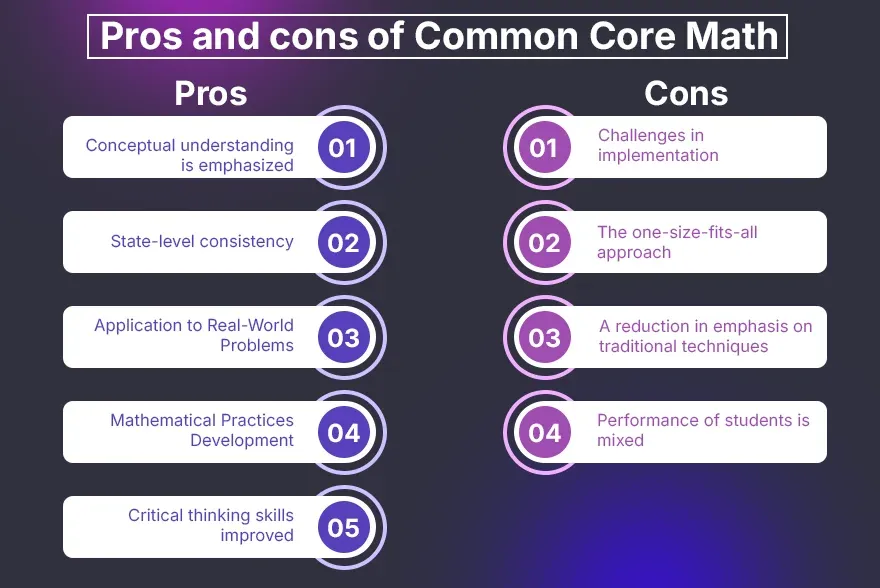AssignmentGPT Blogs
Math. Does it invoke a sense of satisfaction? Or does it simply invoke a sense of doom?
Whatever you say, math is integral. It’s because it makes up a lot of stuff. By a lot, we mean almost everything. From the word count on this blog to the endless lines of code, APIs and algorithms on the webpage you’re currently viewing – math is omnipresent.
Realizing the importance of math, the US government introduced ‘Common Core Math’ in 2010. This system was designed to redefine how math is taught and learned across states.
Let’s know more about it.
Quick Summary
In this blog, we’ll learn what common core math is, and its pros and cons.
Common Core Math, What is it?
Common Core Math was designed to establish clear, consistent math learning objectives for students across different states.
It focuses on understanding math concepts deeply, while learning how to apply them into real-life situations. It is a shift from simply memorizing formulas and solving repetitive problems.
With CCSS math you get multiple ways in which you can arrive at a solution. Now that we know what Common Core Math is, let’s understand its pros and cons.
Pros of Common Core Math
Now, let’s move on towards getting to know the common core pros and cons. We’ll start with the pros first.

1. Conceptual understanding is emphasized
Giving rise to conceptual understanding is one of the core goals of Common Core Math.
This is a shift from simply getting the right answer to actually knowing why an answer is correct. It is aimed at encouraging students to think critically and develop a deeper connection with math.
With this, math skills are reinforced rather than emphasizing on just memorizing formulas and steps.
2. State-level consistency
Before Common Core was introduced, different states had varying educational standards. So, a student moving from one state to another would find themself either ahead or behind their peers.
But, Common Core Math creates a uniform standard that is followed nation-wide. This is beneficial for students that are moving from state-to-state – they won’t have to catch up or repeat lessons.
3. Application to Real-World Problems
Common Core Math offers real-world applications when it discusses problems.
This makes a big difference as it helps see the relevance of math in real life. Examples include calculating discounts, measuring data and even analyzing data – all of which are skills that can be used in the real world as well.
This makes math engaging and also shows students how these skills can be applicable in the future.
4. Mathematical Practices Development
8 mathematical practices in Common Core math help students develop skills beyond problem-solving.
Learning includes constructing logical arguments and learning to reason through abstract arguments. These are skills that also translate into the real world, not merely in books.
So, this is where Common Core Math comes into play – giving you problems that include solving real-world problems.
4. Critical thinking skills improved
Common Core Math focuses on encouraging students to approach problems from different angles. This is one of the best benefits of common core math.
This helps develop versatile and robust problem-solving skills. So, students then break down complex problems and then approach them from multiple directions – ensuring that they get their critical thinking skills developed in a comprehensive manner.
It also empowers them to not only identify, but to also solve problems as such – being able to communicate their reasoning in a clear manner.
Also read this article : Free Math Problem Solving Websites and Applications
Cons of Common Core Math
With the pros that Common Core Math has, it also has its fair share of cons. Here are the pros and cons of common core standards, let’s explore them in detail:
1. Challenges in implementation
Regarding to theoretical aspects, Common Core Math has shown a good amount of promise.
But, its implementation has faced hurdles. Teachers that have been following traditional methods found themselves unprepared to teach the new curriculum.
Training programs and resources were rolled out in an uneven fashion, leading to educators struggling to adapt.
2. The one-size-fits-all approach
Common Core Math was designed to create consistency. But, it has also been criticized for being too much of a one-size-fits –all-solution.
All students learn in different ways, and while some may thrive under the conceptual approach – others might struggle.
This leads to students that learn better with traditional methods feeling left behind, as their preferred style isn’t emphasized.
3. A reduction in emphasis on traditional techniques
Another critique is the de-emphasis on traditional math techniques, such as memorization and quick calculations.
Some parents and educators argue that while conceptual understanding is essential, certain mathematical skills (like memorizing multiplication tables) are still critical for students to learn.
Common Core's focus on multiple approaches to solving problems may, at times, overlook the value of more straightforward methods.
4. Performance of students is mixed
Finally, while Common Core was designed to improve student outcomes, the results have been mixed.
Some studies have shown improvements in student understanding and application of math, while others have found that test scores have remained stagnant or even dropped in certain areas.
The success of Common Core Math often depends on how well it is implemented at the school and district levels, leading to uneven results across the board.
Conclusion
With any educational reform – there are challenges.
While they may look neat and clean on paper, it actually depends a lot on implementation.
In the end, it is essential that the system is applied properly, and the students as well as teachers get the full advantage of the same.
This was our analysis of what is a Common Core Math and its pros and cons, we hope it helped you understand what it is,and form an opinion!
FAQs
1. Is Common Core Math used in all states?
2. How does Common Core Math differ from traditional math?
3. What are the eight mathematical practices?
Content writer at @AssignmentGPT
Kandarp’s world is powered by conversations, content, and creativity. With experience across branding, literature, publishing, and strategy, he has helped shape identities and stories for businesses across industries. At AssignmentGPT AI, he leads a team that blends sharp content, strong design, and local insight to turn businesses into brands that connect with people.
Master AI with
AssignmentGPT!
Get exclusive access to insider AI stories, tips and tricks. Sign up to the newsletter and be in the know!

Transform Your Studies with the Power of AssignmentGPT
Empower your academic pursuits with tools to enhance your learning speed and optimize your productivity, enabling you to excel in your studies with greater ease.
Start Your Free Trial ➤Start your success story with Assignment GPT! 🌟 Let's soar! 🚀
Step into the future of writing with our AI-powered platform. Start your free trial today and revolutionize your productivity, saving over 20 hours weekly.
Try For FREE ➤








